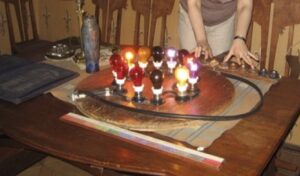It seems three main types of crossmodal correspondences between the senses exist: transfer of information, shared associations, and subjective associations (see our blog for the crossmodal correspondences between the senses).
In this blog post, I have invited Researcher Nicola Di Stefano, Institute of Cognitive Sciences and Technologies, National Research Council of Italy to explain the subjective associations between music and colour. Nicola Di Stefano has contributed numerous publications on both the philosophy and psychology of perception and the aesthetics and psychology of music.
Sounds and colours are two distinct sensory experiences that convey different information about the environment we inhabit. While we typically attribute a colour to every object we perceive, we wouldn’t assert that each object possesses or is inherently associated with a particular sound. Of course, musical instruments produce sounds, and various objects can emit sounds, like hammers, rocks, and sticks, but sound seems to be an ontologically different, namely less foundational, feature of objects compared to colours.
Interestingly, however, intellectuals, researchers, artists, and composers have been long fascinated by the association between those two seemingly radically different sensory experiences. Their idiosyncratic association is evident in sound-colour synaesthesia, one of the most prevalent forms of synaesthesia, a rare neurological phenomenon where stimulation of one sensory (or cognitive) pathway leads to automatic, involuntary experiences in another1. This cross-wiring allows individuals with synaesthesia to experience a unique blending of sensations, such as seeing colours in response to musical notes or chords. Sound-colour synaesthesia has inspired several artworks, including the musical paintings by Kandinsky and Scriabin’s Prometheus, a composition based on the combination of coloured lights and music.

Photo retrieved from: Scriabin and the Possible
Psychologists have also explored the mechanisms underlying the consistent association between certain features of sounds and colours in non-synaesthetes. The concept of “crossmodal correspondence” suggests that certain sensory attributes share underlying perceptual or cognitive processes, leading to associations between them2. For instance, studies have revealed that people tend to associate high-pitched sounds with light or bright colours, while low-pitched sounds are often linked to dark colours3. These associations may arise from shared perceptual features, such as the frequency or intensity of auditory and visual stimuli.
One of the most intuitive ways to explain sound-colour correspondences is psychophysical, suggesting that both sounds and colours are vibratory phenomena. However, the sensory systems that process the two signals are quite different, making it challenging to establish a link between sounds and colours based solely on alleged psychophysical similarity. Additionally, an important distinction lies in the octave similarity in music, where sounds at different frequencies (integer multiples of the same fundamental frequency) share the same pitch class (e.g., “D”), whereas in the domain of colour, there is no equivalent octave repetition.
Furthermore, philosophers grapple with the metaphysical implications of the interplay between music and colour. Music, often described as the “language of the emotions” elicits powerful affective responses in listeners, shaping their emotional landscapes4-5. Similarly, colour possesses symbolic and emotional resonance, evoking mood and atmosphere in visual art and design. The intentional combination of music and colour in multimedia art forms, such as film and digital media, underscores the transformative potential of blending sensory modalities to create immersive experiences.
Whether through the lens of synaesthesia, crossmodal correspondence, or aesthetic inquiry, the convergence of music and colour illuminates the intricate interplay between sensory perception, cognition, and emotion. By unravelling the mysteries of this symbiotic relationship, researchers, artists, and practitioners aim to gain deeper insights into the nature of human experience and the profound ways in which art shapes our understanding of the world.
See our blog for Activities; especially 25-27.
Some suggestions for further listening and watching:
Artists use synesthesia to expand their creative limits
Is Your Red The Same as My Red?
Light Organ (Clavière a lumiére) – Scriabin op 65 no 2
Seeing Sound: How Synesthesia Can Change Our Thinking
Seeing song through the ears of a synesthete
Synesthesia & creating your own score
_______________
1Ramachandran, V. S., & Hubbard, E. M. (2001). Synaesthesia–a window into perception, thought and language. Journal of consciousness studies, 8(12), 3-34.
2Spence, C. (2011). Crossmodal correspondences: A tutorial review. Attention, Perception, & Psychophysics, 73(4), 971-995.
3Spence, C., & Di Stefano, N. (2022). Coloured hearing, colour music, colour organs, and the search for perceptually meaningful correspondences between colour and sound. i-Perception, 13(3), https://doi.org/10.1177/20416695221092802
4Cooke, D. (1959). The language of music. London: OUP.
5Juslin, P. N., & Sloboda, J. (2011). Handbook of music and emotion: Theory, research, applications. Oxford: Oxford University Press.

